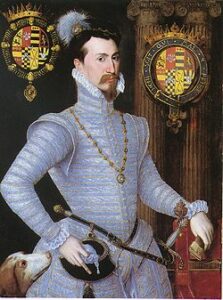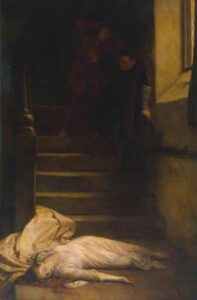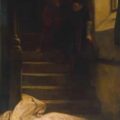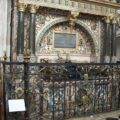
You can read the online version of the article “A Tudor Murder Mystery” at http://www.express.co.uk/posts/view/164401/A-Tudor-murder-mystery, but here is a passage from the article regarding the coroner’s report on Amy’s death, which happened at Cumnor Place on the 8th September 1560, and Skidmore’s theory:-
“Amy did indeed die of a broken neck, at the same time as having no mark or wound on her body, but we now know that she had suffered two head wounds: one was half an inch deep, the other no less than two inches deep. The chilling depth of this last wound transforms our understanding of how she died. What could have caused such severe injuries?
The coroner’s report refers to these wounds as “dyntes”, a Middle English word normally meaning a blow struck, usually by a weapon. Could Amy really have sustained these wounds falling down stairs? Perhaps we might know more if the stairs survived, yet Cumnor Place, left long in ruin after Amy’s death, was demolished in the 19th century.
However a sketch of the stairs has also been unearthed. This reveals eight steps, then a landing, followed by another four steps. If Amy fell from the top of these stairs, it seems likely that the landing would have broken her fall.
And it does not explain how she could have suffered such extreme head injuries and a broken neck. Interestingly, the sketch does reveal that on the landing there was an interlinking doorway, leading outside – perhaps a perfect getaway for any intruder.
The coroner’s report reveals that the jury came to a verdict of death “by misfortune”. For the first time we also know the names of the members of the jury, who included one Sir Richard Smith, better known as “the Queen’s man”. This same Smith wrote to Dudley personally even before the jury had reached its verdict and six years later payments in Dudley’s household accounts reveal that he had given Smith presents.”
As I wrote in my post “Did Robert Dudley Murder Amy Robsart?” back in February, even if Skidmore can prove that Amy Robsart was murdered, which he can’t, then in my opinion Robert Dudley would be the last person I’d pick as chief suspect – Robert Dudley on the landing with the lead piping (or whatever) does not fit. Why kill a woman who was already dying? Why cause scandal and gossip that is certain to make Elizabeth distance herself from him rather than marry him? And could Dudley really bring himself to kill the woman that he had obviously loved when he married her? No, I don’t think so.
Elizabeth Files visitors have written some great responses to Chris Skidmore’s theory as comments on my previous article on the subject and I just want to share a few of them here:-
Christine Hartweg: “Claire, I concur with your conclusion that Skidmore’s evidence does not really support that Amy was murdered, let alone by her husband! Amy’s illness was not only mentioned by two different Spanish ambassadors at different times, but also by one Venetian. The “Mr. Smith” Dudley gave cloth in 1566 is not necessarily Robert Smith of the jury; BTW, this has been mentioned before by Prof. Susan Doran in “Monarchy and Matrimony” (1996), so it was not Skidmore who found this “connection”. The really new thing seems to be the coroner’s report; it is by no means mysterious that they wouldn’t mention (or even recognize) minor injuries on Amy’s body in those times. Perhaps they hadn’t have a thorough look under her clothes (she was a married woman, after all).
Robert Dudley explicitly exhorted Thomas Blount, his steward to whom he wrote his letters after Amy’s death, to press for the jury to thoroughly examine her body! So, perhaps that was not the custom. As regards two “different” impacts, a 16th century coroner/pathologist could not distinguish between them occurring simultaneously or by differing causes. The letters cited in “Suspicious death that made the Virgin Queen” – An article in “The Sunday Times” are, without exception, well known and were all send to Thomas Blount directly after Amy’s death. Of course I will read his book but I am afraid Mr. Skidmore has little hard evidence to solve the “mystery” and rather speculates quite boldly against Robert Dudley.
I’ve just looked up Anthony Forster’s financial dealings with Robert Dudley which he had since at least 1557, when he borrowed over 1,000 pounds from Forster who was later a high-ranking officer in Dudley’s household. In “Household Accounts and Disbursement Books of Robert Dudley, Earl of Leicester” Cambridge UP (1995), the editor, Dr. Simon Adams (the greatest expert on Dudley), lists 300 pounds Dudley received from Forster in May 1559. Adams also comments on 310 pounds Dudley paid to Forster on 16 September 1560, eight days after Amy’s death, and 25 October 1560, in two instalments. Adams thinks the nearness to Amy’s death would perhaps point to “expenses of winding up her household”. So, nothing new on that front either! BTW, Dudley didn’t “maintain for years” that he didn’t know Robert Smith (as they say in the press): He never mentions him after the letter to Blount regarding the jury, where Dudley says he received a letter from “one Smith”
Robert Parry: To be sure, the discovery of the coroners report by the author is a very exciting and important development. However, fractures to the skull are consistent with a fall from a high place, so nothing really changes in terms of whether it was an accident or not. Moreover, it must remain very unlikely that Robert would have been culpable in the affair. He was neglectful of his wife, yes, perhaps unkindly so. But it was not uncommon for a husband thus highly placed at court to be away from home for weeks or even months on end. It was part of the job description. Moreover, he knew, as did Cecil and the Queen, that it was sadly (in those days) only a matter of time before Amy succumbed to her illness, and there would have been nothing to gain for him or Elizabeth by having this hastened unnaturally through violent means – in fact quite the reverse.
Other pieces of evidence against Dudley are largely hearsay or rumour spread by hostile forces. For example, why he did not attend the funeral? Sarah Gristwood in her excellent biography on Elizabeth and Leicester states that it was common in those times for personal mourners at a funeral to be of the same sex as the deceased. So nothing odd there.
The gift to Robert Smith and others. It was normal for a man of Dudley’s estate to hand out gifts by way of payment to others. It occurred constantly, on an almost daily basis. Nothing out of the ordinary there. And was it even the same Smith as …
Christine: Why bribe the jury if they don’t even bother to write a harmless report? Or otherwise, why should we take serious the coroner’s report if we don’t accept the verdict of that same jury? I wonder why Robert should have been so cunning as to write all those perfectly harmless sounding letters in bad faith or have forged them all when he was so stupid as to leave a trace of allegedly suspicious payment in his account book? Why didn’t he have killed Appleyard? Why did he even rescue him from the gallows in 1569, and let him live out his days in the Bishop of Norwich’s palace in 1574, where he could have talked! Anthony Forster was Dudley’s treasurer, and Robert even paid him back +1,900 pounds in 1558, received from him 300 pounds in 1559, so why not pay him 310 pounds in 1560?
Sir Richard Smith is not so unknown either: he figures in the footnotes to this scurrilous anonymous anti-Dudley gossip chronicle reprinted here: “Religion, Politics, and Society in Sixteenth-Century England” (Camden Fifth Series) (2004) (p. 66):
“And her death he mourneth, leaveth the court … Himself all his friends, many of the Lords … and his family be all in black, and weap dolorously, great hypocrisy used.”
Did Sir Henry Sidney (admittedly a brother-in-law) lie when he privately said he had inquired on his own and was convinced it was not murder? Did Elizabeth lie all her life and at the time she “declared and testified his innocence” officially in 1584 after the publication of “Leicester’s Commonwealth”? How could she be so close, also physically close, with a murderer of women? How could she pervert justice to such a degree? She was not Mary Queen of Scots! How could any other woman want to marry him? (There were at least two of them).
After the death of his son Dudley wrote to his friend Christopher Hatton: “The afflictions that I have suffered may satisfy such as are offended, at least appease their long hard conceits: If not , yet I know there is a blessing for such as suffer; and so is there for those that be merciful.”
Bess Chilver, writing about Skidmore’s article in “The Daily Express”: I’ve come across this rather late but because I’ve seen an essay in the Daily Express by Chris Skidmore.
I will say from the outset that I am not impressed with Chris’ conclusions based on the essay he has written – it makes me think the book will not be much better.
His evidence that there was foul play and probably by Dudley and possibly Elizabeth I as well (though indirectly) is as follows:
He states that the coroner’s report shows that Amy had indeed died of a broken neck, but there were also the two head wounds – “…one was half an inch deep, the other no less than two inches deep.”
He questions whether a fall down stairs would cause these wounds (he doesn’t state WHERE the wounds are on the head). He then turns his attention to Cumnor Place, commenting that it was demolished in the 19th century. Such a shame that the staircase doesn’t exist isn’t it? Or is it. Read the quote from the article…
“…However, a sketch of the stairs has also been unearthed. This reveals eight steps, then a landing, followed by another four steps. If Amy fell from the top of these stairs,, it seems likely that the landing would have broken her fall. And it does not explain how she could have suffered such extreme head injuries and a broken neck.”

I don’t know what sketch was used, but the article has a black and white image of the illustration of the staircase that is on this very page! [the painting of Amy Robsart lying at the bottom of the staircase]
Lets go on with the quote:
“Interestingly, the sketch does reveal that on the landing there was an interlinking doorway, leading outside – perhaps a perfect getaway for any intruder.”
Oooh – this line really makes the historian in me angry. He is making a conclusion based on a sketch that he has not proved (in this article anyway) was made IN THE 16th CENTURY. At best it is a SECONDARY level evidence. He has already said that Cumnor Place has not existed since the 19th century and previously to that was falling down.
How can Chris Skidmore state that the door on the landing (assuming it DID exist!) led outside. Assuming the sketch in the article (which is the same as the illustration on this page) is the sketch Chris apparently found (and I will say I am not sure if it is or not), then all he has for THAT theory is a window through which the viewer cannot see anything. The door could merely lead to a small room. If it led outside its on a higher level than the ground so that would mean another series of steps OUTSIDE. Which I think is unlikely to be the case.
He also implies that the coroner’s report provides the names of the juror’s for the first time and mentions Sir Richard Smith. As has already been mentioned my old Personal Tutor Prof Susan Doran already knew that Sir Richard Smith was on the Jury and was the foreman. He also comments that Sir Richard Smith was the “Queen’s Man” – clearly this snippet of info clearly implies in Skidmore’s mind that Elizabeth I was in the know of the whole sorry affair!
Skidmore goes on to say that Smith write to Dudley before the jury verdict but he doesn’t say what was in the letter. Then he comments the payments/presents made by Dudley to a Mr Smith (Skidmore is assuming its the same man) SIX YEARS LATER. Again, as someone else has pointed out, it may not be the same Smith. I also can’t see that IF the two Smiths were the same person AND had been nobbled, that he would have waited 6 years for a pay off! It also totally ignores the bald fact that gift giving was a form of currency in the 16th century court.
I would also point out that Chris Skidmore claims HE found the Coroner’s Report. I quote from the article:
“…For centuries, it has been thought impossible to know [what happened] since the original coroner’s report into Amy’s death has been presumed lost. Yet, in the course of my research into Amy’s death, I discovered it in the archives at the National Record Office in Kew, buried among a stack of legal files written on vellum…”
Bearing in mind the evidence above that Steve Gunn found it, this one paragraph means I simply can’t take Chris Skidmore seriously. Taking credit for someone else’s work – even if it was merely finding the document, is not right.
Taking just this article written BY the author of the book “Death and the Virgin” (who does he mean here?), I would not be wanting to read his book as I really feel he has had a theory: Dudley and probably Elizabeth are involved in murdering Amy. Skidmore is clearly of the view that Amy was murdered. He has looked for evidence to fit that theory.
He has completely ignored the concept of “Cui bono?” – to Whose Benefit? What was the motive in murdering Amy?
Further Reading
- “Elizabeth, the Queen” by Alison Weir – Has a good section on Amy’s death and Weir’s theory that Cecil may have been the one behind her mysterious death.
- “Death and the Virgin Queen: Elizabeth, Dudley and the Mysterious Fate of Amy Robsart” – Chris Skidmore’s book.
- “Suspicious death that made the Virgin Queen” – An article in “The Sunday Times”
- Did Elizabeth I’s lover have wife killed so he could wed the Virgin Queen? – Article in “The Daily Mail”
- “A Tudor Murder Mystery” – Article in “The Daily Express”






